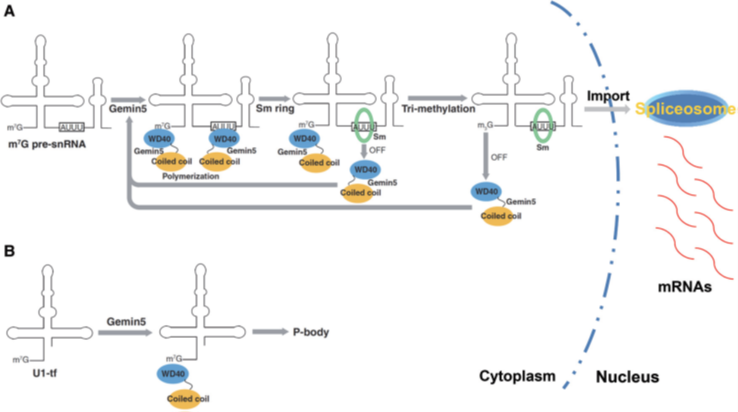Scientists from USTC Reveal WD40 Domain Hooks pre-snRNAs with Collaborators from Canada
XU Chao, a Professor at school of Life Sciences, the University of Science and Technology of China (USTC), uncovered the molecular mechanism of the recognition of pre-snRNAs by the Gemin5 WD40 domain, contributing to better understanding of cellular activities, in a project collaborated with Professor Jinrong Min from University of Toronto.
Pre-small nuclear RNAs (pre-snRNAs) is delivered to the heptameric Sm ring with the survival of motor neuron (SMN) complex in cytoplasm. Gemin5 is a WD40 protein component of the SMN complex and responsible for recognizing pre-snRNAs. And Gemin5 has been reported to specifically bind to the m7G cap. Based on those previous findings, this study further uncovered the mechanism of how Gemin5 recognizes pre-snRNAs.
The researchers identified the crystal structures of the WD40 domain of Gemin5 and uncovered that the WD40 domain of Gemin5 recognizes the Sm site and m7G cap of pre-snRNAs via two distinct binding sites by respective base-specific interactions. And it is also proven that WD40 domain of Gemin5 is both necessary and sufficient for binding the Sm site of pre-snRNAs. In addition, the paper also found a novel role of Gemin5 in escorting the truncated forms of U1 pre-snRNAs for proper disposal.

(The process of WD40 Domain recognizing pre-snRNAs. Image by XU Chao & Jinrong Min)
The work was published as an advance online paper on Genes & Development(Genes & Development 2016, doi: 10.1101/gad.291377.116). Professor Chao Xu and Professor Jinrong Min are corresponding autors of the paper. This project was funded by the National Nature Science Foundation of China (31570737) and by the ChineseGovernment “1000 Youth Talent Program.”
The link of the paper:http://genesdev.cshlp.org/content/early/2016/11/10/gad.288340.116.abstract
Back
